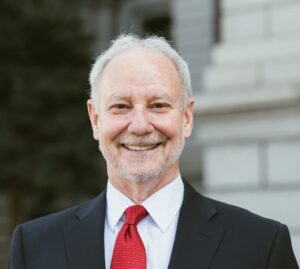The clock is ticking on Colorado employers who don’t now offer retirement-savings plans for their workers, as many must change their practice by February or enroll employees in a benefits program launched this year by the state of Colorado.
Legislators in 2020 approved creation of the SecureSavings Program, arguing that too many state residents aren’t putting away money for retirement and soon could end up costing the state $2.5 billion annually in public benefits from Medicaid to food stamps. The Colorado Treasurer’s Office has estimated that nearly 40% of Colorado workers – about 940,000 people — don’t have access to retirement-savings accounts through their workplace.
Treasurer Dave Young and his staff began sending out notices early this year to employers without registered retirement-savings programs that they either must start such a program or sign up to be a part of the state-run offering. The mandate applies to any company that has been in business for at least two years and that has five or more employees — fulltime and parttime combined — who are at least 18 years old.
Why the state believes the program is needed
Employers don’t have to pay to be a part of the program, but those without their own retirement plans must register at ColoradoSecureSavings.com and then upload their payroll and employee information to the system. The state then will notify those workers that they have 30 days to opt out before it automatically begins deducting 5% of their earnings and putting them into a Roth IRA account controlled by the treasurer’s office but managed with outside advice.
Studies have found that individuals offered a retirement-savings plan through their employer are 15 times more likely to save money for their post-work years, Young said during a webinar hosted Wednesday by the Colorado Chamber of Commerce and Fidelity Investments. But with fewer employers offering defined-benefit pensions and younger workers moving around more frequently between jobs, such simple opportunities to jump into saving can be harder to find.
“People are just not saving like they should be for retirement, and as a result, when people go to retire, they don’t have enough through Social Security,” Young said. “Using payroll to do this is the easy button. It really makes a difference.”

Colorado Treasurer Dave Young
How SecureSavings affects employers
When passed into law, the program generated controversy.
Some business groups, which have fought mandates for years as they did this year, questioned whether pushing younger and lower-wage workers into savings accounts was a good idea when many needed the money for more immediate needs ranging from rent to car repair. And business owners worried that while they were not required to contribute financially to the program — in fact, they are barred from contributing to workers’ Roth IRA accounts — the implementation would be an administrative burden for them.
The treasurer’s office and Colorado SecureSavings Program Executive Director Hunter Railey have taken several steps to ease the burden on both employers and employees.
In addition to allowing workers to opt out initially, the program lets them to contribute whatever percentage of their earnings that they want to put in, up to a savings level of $6,500 per year plus an additional $1,000 for those who are 50 or older. While the standard individual contribution for those who don’t want to manage their account is 5% to begin with, rising 1% annually until it hits 8%, savers can raise or lower that contribution as they want, even bringing it to 0% if they need to take a break, Railey noted.
Employers, meanwhile, have no fiduciary responsibility for the savings program, Railey said. They must not encourage or discourage employee participation, provide investment or financial advice or attempt to manage changes that employees must make, such as adding beneficiaries or opting out.
Deadlines
Rather than establishing deadlines for employers to sign up this year, the program has put out “preferred entry times” – March 15 for employers with 50 or more workers, May 15 for those with 15 to 49 on staff and June 30 for companies between five and 14 employees. It won’t be until February when employers who don’t offer qualified retirement plans will incur penalties of $100 per employee, up to $5,000 annually, for not registering for SecureSavings, Railey said.
As of Monday, the program had netted 40,911 participant employees from 7,306 enrolled employers who either have begun saving or are within the 30-day opt-out window, said Sheena Kadi, public information officer for the treasurer’s office. The program already has amassed $2.75 million in total assets.
But just as the state is working to get employees enrolled in SecureSavings, private financial planners are eager to reach out to employers and tell them they also have options that could fit their workers better than the state’s offering.
Comparison with private retirement-savings plans
Kirsten Hunter Peterson, Fidelity vice president of workplace thought leadership, noted that workers who invest in a traditional 401(k) account can save more than $20,000 a year by going that route — and get employer matching contributions not allowed in Roth IRA accounts. Thanks to a recent change in federal law, small businesses that don’t want to manage retirement savings accounts also can join Pooled Employer Plans in which unrelated can band together to enjoy similar benefits to traditional 401(k)s.

Kirsten Hunter Peterson is vice president of workplace thought leadership for Fidelity Investments.
At a time when many employers are struggling with labor shortages, offering retirement-savings accounts has become more of a differentiator, and Hunter Peterson said that she’s seen a boost of interest in the different kind of plans that are available now. She noted that under that same recently passed federal law, employers can qualify for as much as $5,000 in tax credits to help them in setting up company retirement-savings plans.
“It truly has never been a better time to shop around for retirement benefits,” Hunter Peterson said. “You probably do have more options than you think you do.”
The Treasurer’s office doesn’t expect SecureSavings participation to include all 940,000 people without direct access to a work savings account, and Young has said he doesn’t care whether employers sign up for the state program or are spurred by the law to offer their own benefits. But he wants those workers by next year to have been able to consider their options and decided whether and how they will start socking away money for the future.
“My goal is to create more savers,” the second-term Democrat said. “How they do that, I’m really agnostic about it.”
